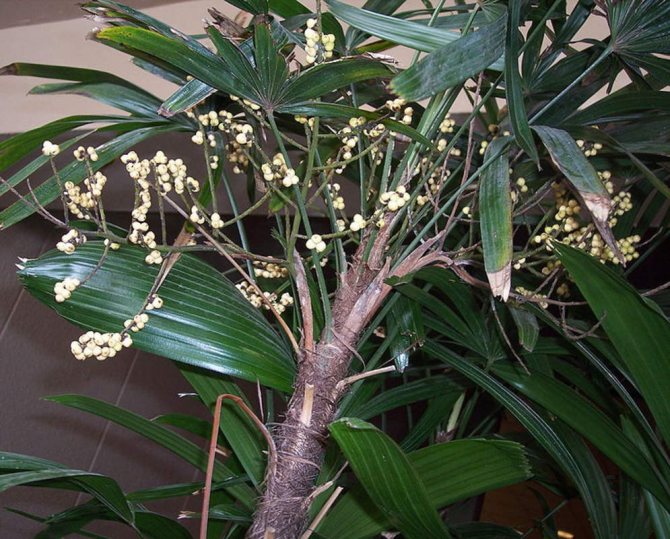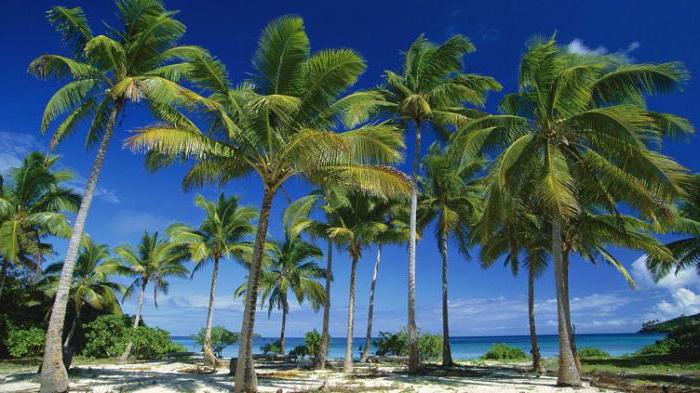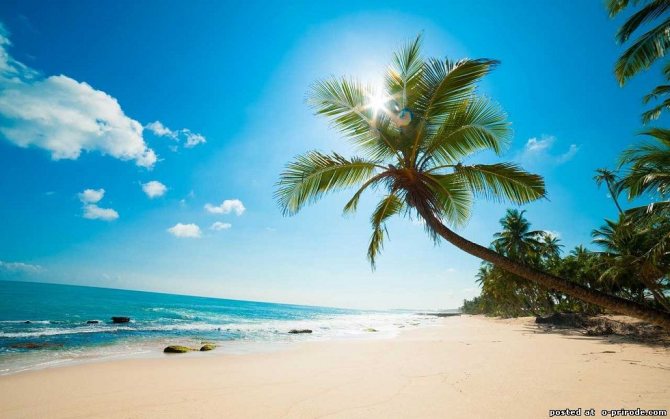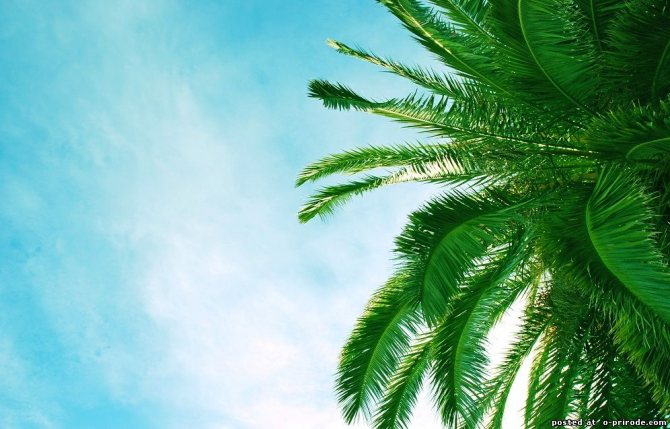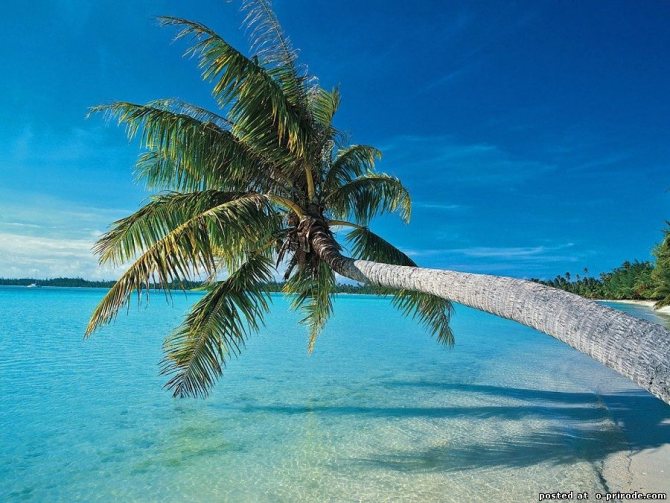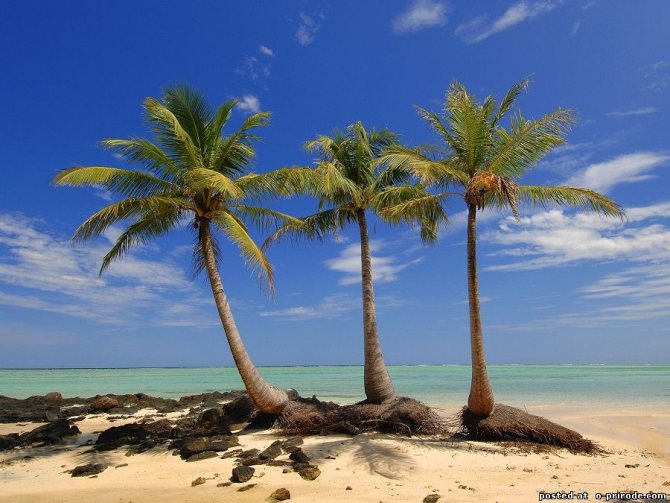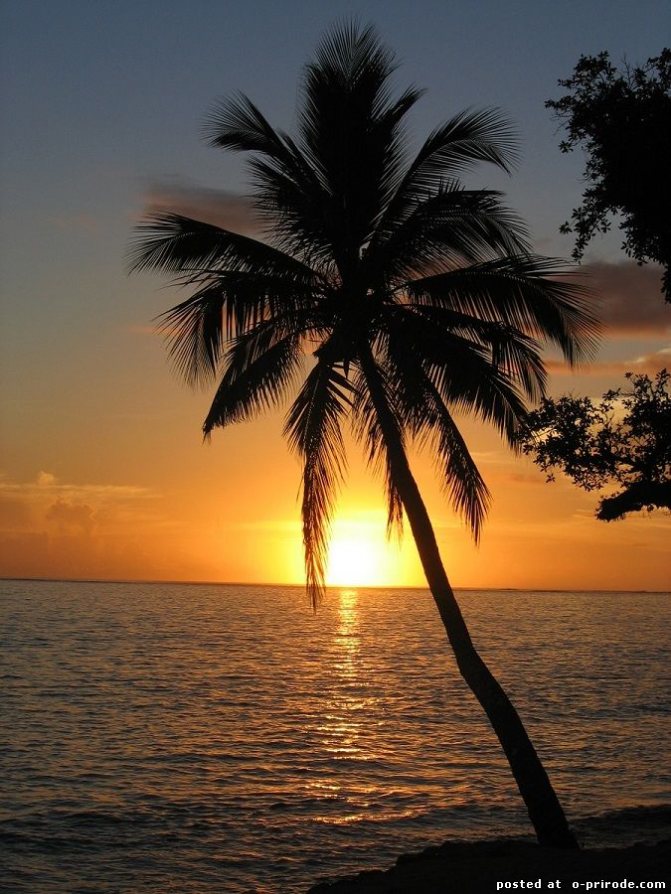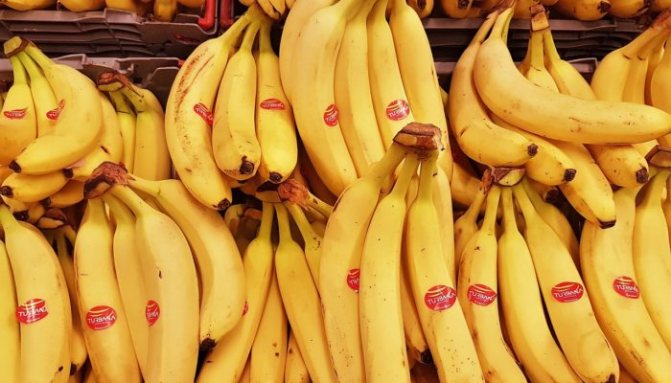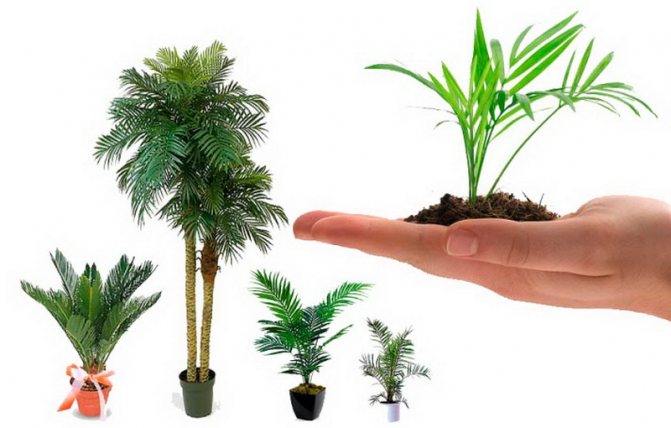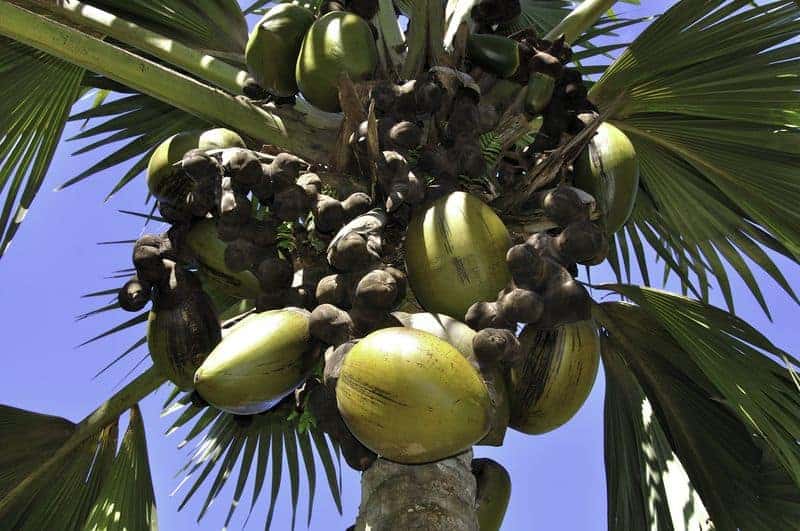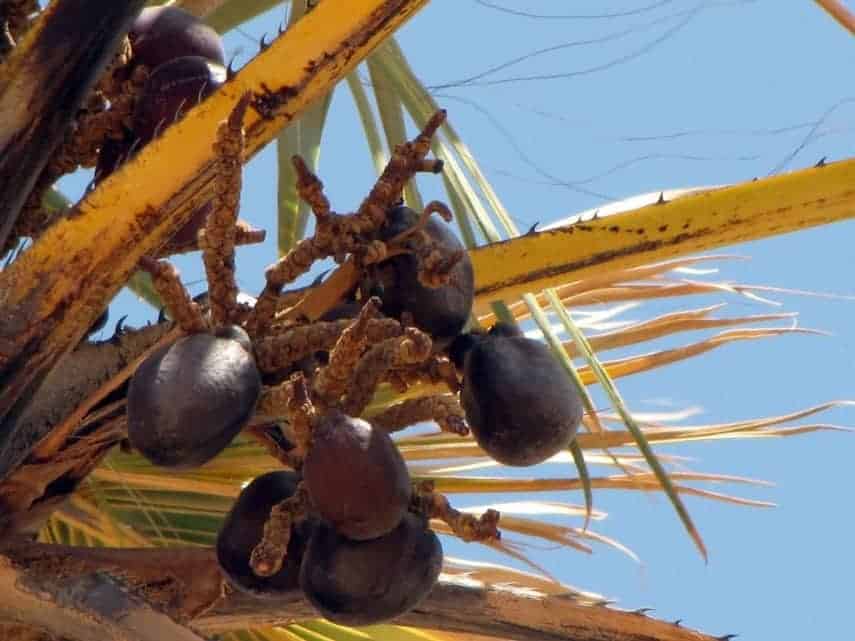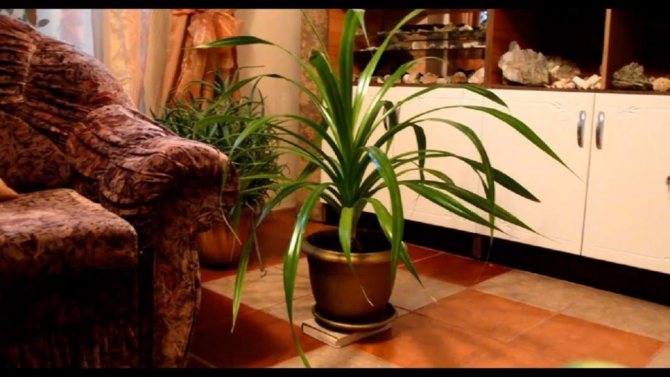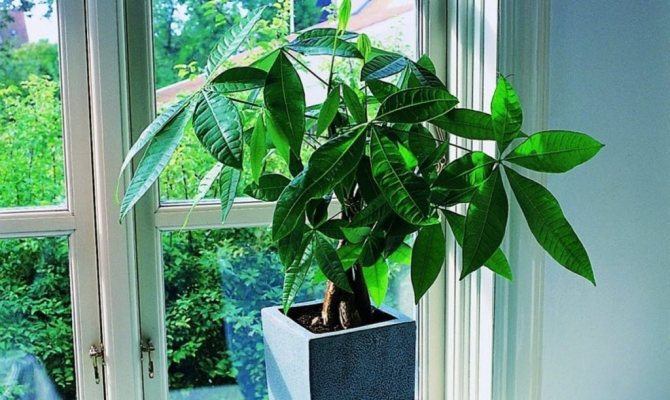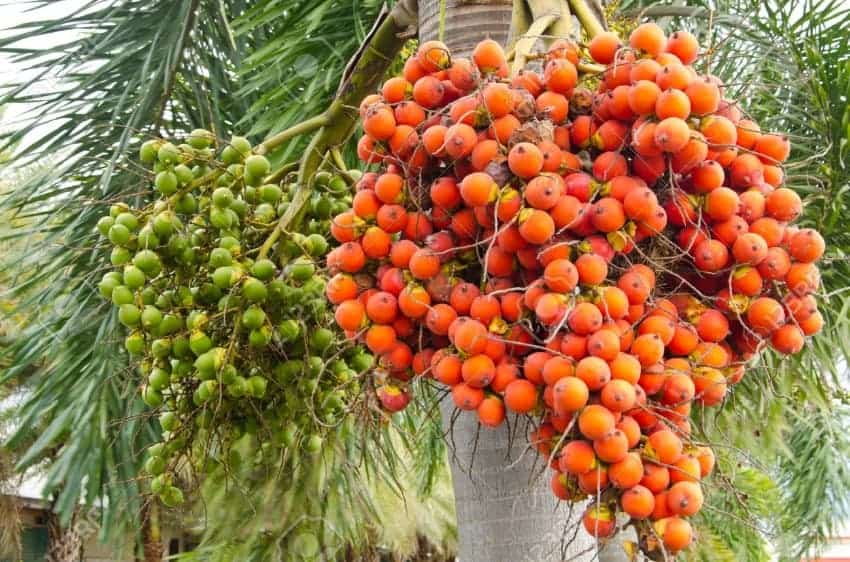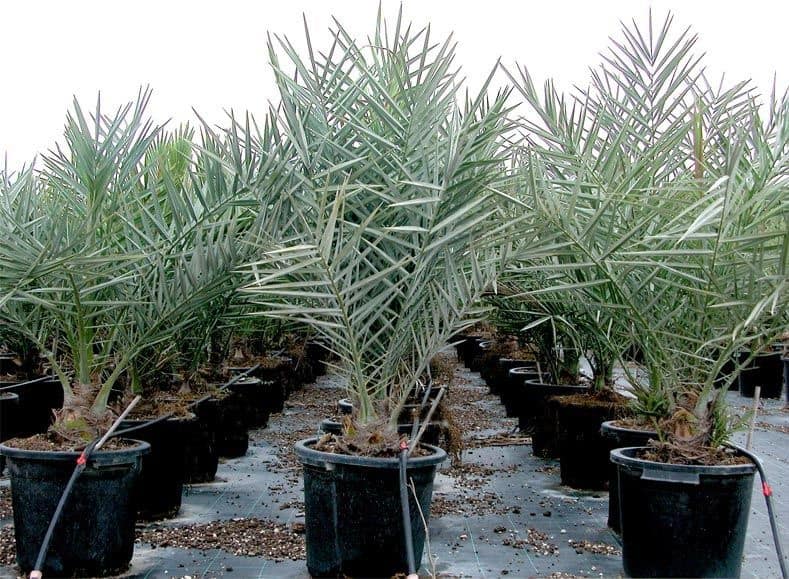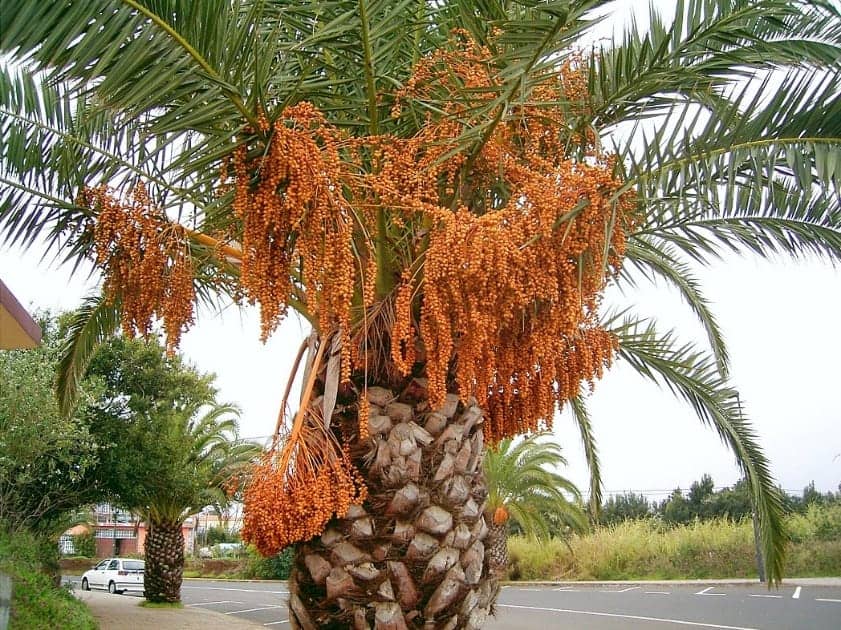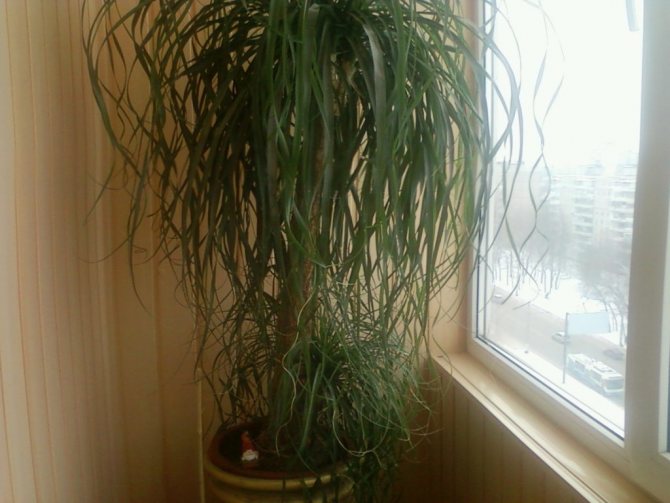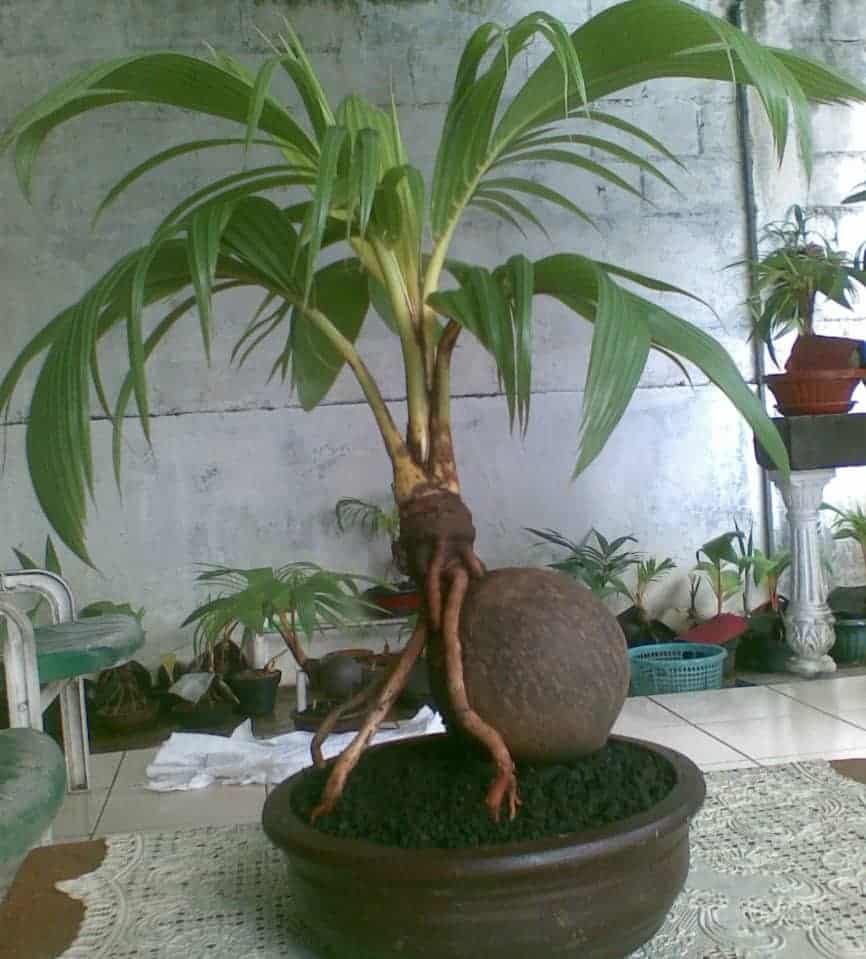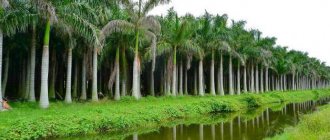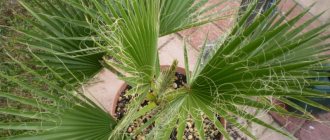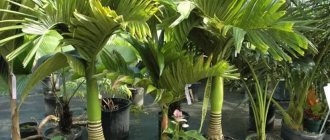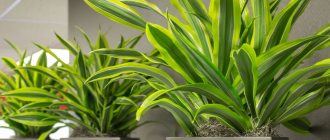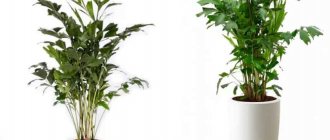Palm trees grow in different places, not only on the beaches.
Typical of a tropical paradise, palm trees are much more significant than you might think. Most people imagine a sunny beach when they see a palm tree - but these sturdy plants can grow in other places as well. Here are 10 things you may not have known about these tropical beauties:
1. There are over 2500 species of palm trees. The Arecaceae family of plants includes amazingly diverse species found throughout the world, from deserts to rainforests.
2. Not all palms are "trees" and not all plants called palms are real palms. These evergreens can grow in the form of shrubs, trees, or long woody vines called vines. Plants such as yucca palm, Torbay palm (pictured), sago palm, and traveler's palm are not part of the Arecaceae family.
3. Palm trees have two different types of leaves: palm and feathery. Palm leaves, like hands, grow in a bunch at the end of the stem. Pinnate leaves look like feathers growing on either side of the stem.
4. Palm trees are important religious symbols. In the Bible, the people of Jerusalem welcomed the triumphal Jesus just a week before his death and resurrection, a tradition now known and celebrated as Palm Sunday the week before Easter. Palm trees are mentioned dozens of times in the Bible and the Koran. In Judaism, palms represent peace and abundance.
5. Many staples come from palm trees. Coconuts are an obvious product of palm trees, but did you know that dates, betel nuts, and acai fruits also come from palm trees? Palm oil, as its name indicates, also comes from the fruit of the oil palm.

The Ceroxylon quindiuense, or Quindio wax palm, dominates the Cocora Valley in Colombia.
7. The tallest palm tree can grow up to 60 meters! The Quindio Wax Palm (seen above), Colombia's national tree, is the tallest growing palm species.
8. The coconut palm has the largest seeds of any plant on Earth. The seeds can be up to 20 inches in diameter and weigh up to 66 pounds!
9. Palm trees have a history with people as old as the first societies. Archaeological finds have shown that the date palm was widely used in Mesopotamian society for food and other purposes. The Romans gave palm branches as a symbol of triumph to the winners of games and wars.
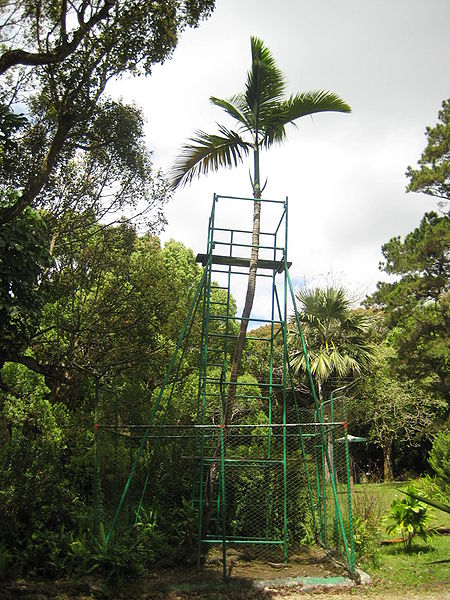

10. Have you ever heard of palm wine? Also called "calla", palm wine is a common alcoholic spirit in the regions of Asia and Africa. It can be crafted from coconut palms, date palms, Chilean wine palms, and more.
Although many palm species are sturdy and plentiful, as many as 100 species are endangered due to deforestation and unsustainable growing practices such as the heart of the palm, which comes from a part of the tree that cannot be restored. The rarest palm is Hyophorbe amaricaulis. The only remaining one currently lives in the Curepipe Botanical Garden in Mauritius (pictured).
Types of palm plants
Palm is a southern woody plant that grows exclusively in tropical and subtropical climates. The Palm family belongs to flowering plants and has about 185 genera and 3400 species.There are especially many of these plants in the zones of Southeast Asia and in the tropical countries of South America.
In colder regions, palm trees can be seen in the Mediterranean and North Africa, Crete, Japan and China, northern Australia, etc.
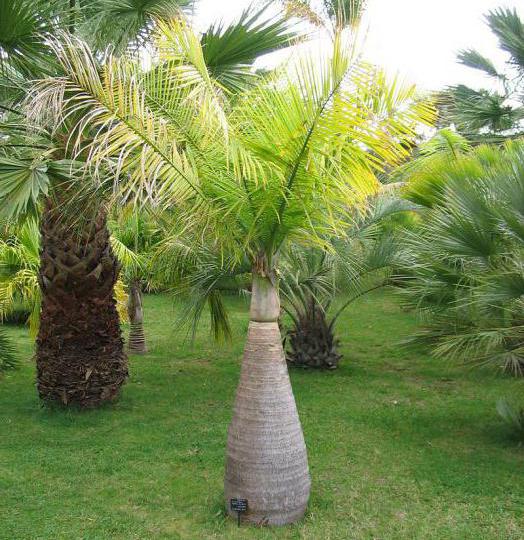

Palm trees can be found in completely different places, ranging from the sea coast to the slopes of the highlands, near swamps and forests, as well as in hot oases in the desert. However, most of all they prefer humid and shady areas with a tropical climate, forming continuous thickets. Palm trees are also widespread in the African savannas, where they can easily withstand drought and hot winds.
Spread
Bananas are native to the tropical latitudes of Asia and Africa, as well as the islands of the Pacific Ocean. The most northern point where bananas grow is the Japanese island of Ryukyu.
Although these plants are inhabitants of tropical latitudes, they do not grow in areas where drought lasts more than three months, and in order for them to produce a good harvest, the monthly rainfall must exceed 100 mm.
Bananas are preferred in sour, mineral-rich soil. The presence of potassium, phosphorus, nitrogen in the soil is especially important: this allows you to annually collect about 400 centners of fruits per hectare. Optimum temperature indicators for plant growth during the day range from 25 to 36 ° C, at night - from 21 to 27 ° C. If the temperature of the air where bananas grow is low and is 16 ° C, the growth rate slows down, and at 10 ° C it stops. True, some types of bananas, such as Rajapuri, can withstand temperatures around freezing.
Plants in the mountains feel good. They can usually be seen about 900 meters above the ocean surface. In some latitudes, they are found even higher: the maximum height where bananas grow was recorded in New Guinea and is about 2 thousand km above sea level. m.
Forms and structural features of palm trees
Palm trees are distinguished by a wide variety of growth forms:
- treelike: Cuban, royal, umbrella-bearing corypha; washingtonia thread; barrigona, hyphaena of Thebes (doom-palm);
- shrubby: chamedorea lanceolate, acelorapha;
- stemless: shrub saw palmetto, Wallich herring, creeping saw palmetto;
- climbing vines: calamus.
The original features of the structure of palm trees are that the plant does not have the usual botanical elements, such as the trunk and branches:
- Its "trunk" is formed from the remnants of obsolete leaves, which harden and form a column; it can only grow upward, but not in width, and this process is quite long (1 m grows in 10 years);
- the roots form a bulb at the base, from which small roots extend;
- nutritious juices circulate only through, due to which palms are considered refractory;
- due to the ability of the leaves to re-germinate from their own trunk, this plant is called the "phoenix tree".
Among the palm trees there are mono- and dioecious plants, in the second option there are male plants that pollinate the female, respectively, the fruits are only on the latter. In nature, pollination occurs with the help of the wind, and in cultivated plantings, people do it manually. Fruit ripening lasts about 200 days.
How banana grass grows and bears fruit
Despite all the efforts of the breeders, it was possible to withdraw just a few varieties, which can bear fruit at temperatures below 10 degrees. All other varieties, and there are more than two hundred of them, simply fall asleep at temperatures below 16-10 degrees, almost completely stopping their vital activity.
The fruits of banana plants grow in one large bunch on a stem that sprouts between the leaves of the false trunk, and not at the very top, like coconuts. One such bunch can contain from several tens to several hundred fruits, depending on their size and type.
The opinion that a banana is a fruit is fundamentally wrong, because only the fruits of trees are considered as such. But berries are already growing on the bushes and grass. Therefore, bananas are typical berries, along with raspberries, currants or strawberries.
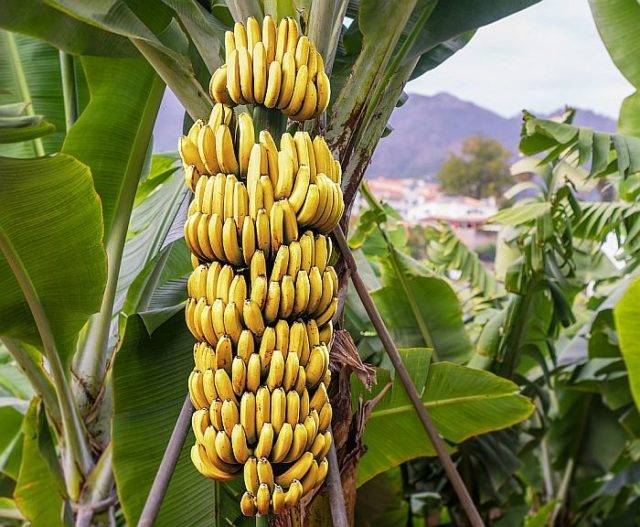

Palm tree fruits
Palm is one of the most useful plants for humans, because many of its varieties give very tasty and even medicinal fruits: dates, coconuts, etc. They are used to make flour, oil, alcoholic beverages, fibers are also produced on an industrial scale, from which bags and other fabric products.
The most useful fruits for humans that grow on a palm tree are dates and coconuts.


The date is a cylindrical berry with a thin peel, its average weight is 7 g, of which 2 g is a seed. The sugar content in it reaches 70%, the calorie content is 30 kcal / pc. 10 dates a day provide the human body's daily need for magnesium, sulfur, copper, iron and a quarter of calcium.
Many tasty and healthy ingredients are extracted from the coconut:
- juice or water - a clear liquid, coconut endosperm contained inside the fruit, as it ripens, it mixes with oil and hardens;
- coconut milk - obtained after pressing grated copra, it is white and quite fat, after adding sugar it is very tasty;
- oil - extracted from coconut copra, is a valuable product due to its high content of fatty acids, used in cosmetics and medical treatment.
Yubeya Chilean
Another plant known in its group, the second name of which is the elephant palm, she received it for its impressive dimensions and a trunk very similar to the limb of an elephant. With a trunk height of 15–18 meters, it reaches a meter in girth. The crown of the tree is lush, it consists of 3-4 meter leaves.
The homeland of Yubey is Chile, however, due to its unpretentiousness and resistance to lower temperatures, the plant has taken root in the USA, Japan, and some European countries.
There is another connection between the Chilean jubiea and elephants - in its fruits there is a seed filled with a liquid substance that resembles coconut milk. Over time, the liquid turns to jelly and later becomes as hard as bone. From it, craftsmen make various crafts that can be confused with ivory. To prevent this from happening, the carvers leave some shells on the surface so that there is no doubt - the thing is really made of plant materials. In addition, wine is made from yubey juice, for which the palm tree was called wine.
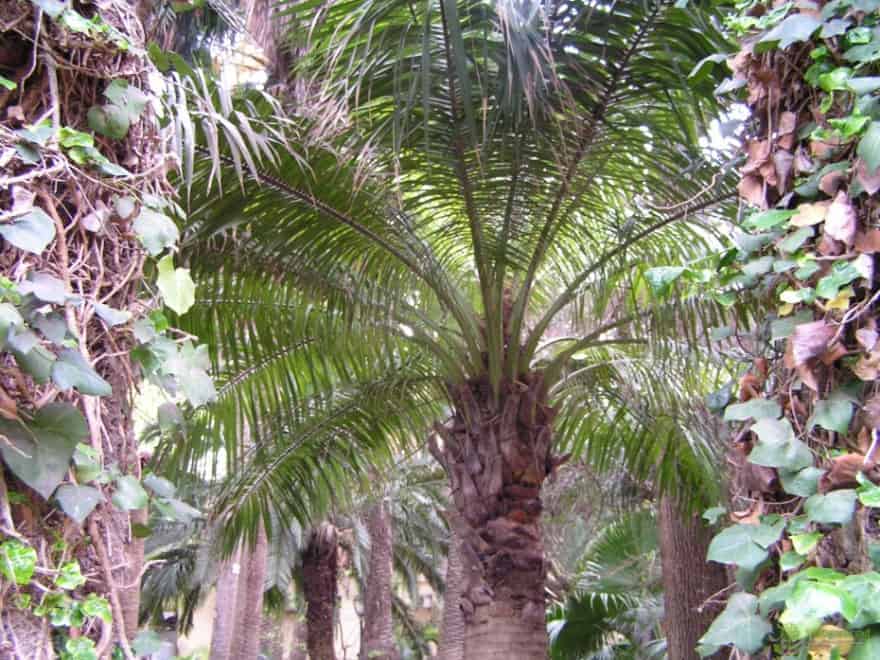

Jubaea Chilean
Coconut palm
It is not for nothing that this plant is called the “tree of life” in the tropics, because the locals use almost all of its parts for food and the manufacture of various products, leaves and wood are used in construction.
However, for unlucky people, this palm tree can become a “tree of death”, since according to statistics, 150 people die every year from blows of such nuts on the head. The weight of an average coconut is about 1-3 kg, so dropping it even on the roof of a car leaves a dent, and it is deadly for the head.
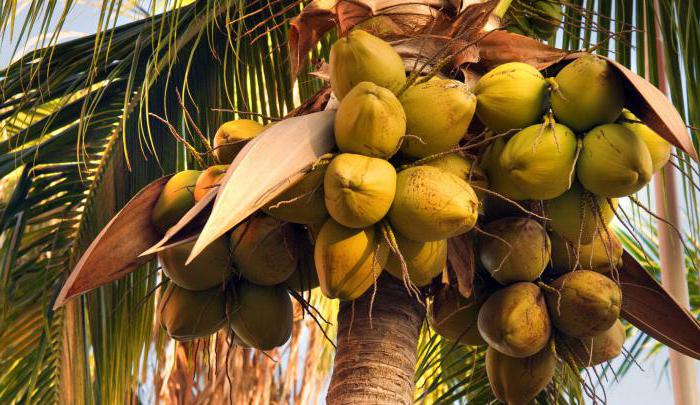

Coconut fruits grow in groups of 15-20 pcs. and mature in 8-10 months. Fruiting in trees lasts up to 50 years, during this period each palm produces 60-120 nuts annually.
Outside, the coconut is covered with a tough shell, inside there is pulp and liquid, which becomes sweet as the fruit ripens. You can clean it with a knife or machete.
Butya capitate
The Latin name is Butia capitata. This type of palm tree is native to Brazil. It grows in mountainous areas on sandy soils. The buttock trunk has a characteristic capitate thickening at the base, gradually tapering upward.


The emergence of new leaves begins in April and continues until the end of September. During the growing season, from 4 to 9 leaves are formed, and each lives up to 7 years.
The palm tree is beautiful with its openwork crown, lush inflorescences and fruits.
In the open ground of the Black Sea coast of the Caucasus, butia begins flowering and fruiting from 10 to 12 years of age. In indoor conditions, it rarely blooms.
In the butie, the seed is rounded, oblong, pointed at the ends, up to 20 mm long and 10 mm wide, with three distinct sutures. In the lower part there are three rounded pores closed with loose corky tissue - this is the place where the embryo exits.
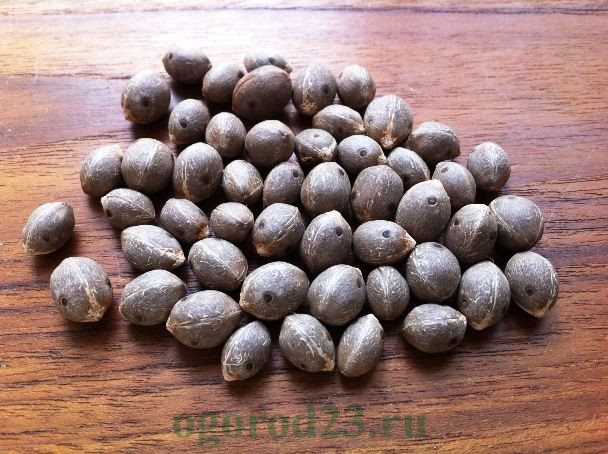

The seeds contain about 60% liquid coconut oil. The fruits of the boutique are used in raw food and for the manufacture of jams and liqueurs.
Before germinating the seeds of bututia, it is recommended to carry out their long-term stratification in wet sand or peat. Mechanical stratification is possible - filing of seed shells or careful destruction of corked tissue with a sharp metal object.
Freshly harvested seeds germinate after stratification for 35-45 days. In some cases, the process can take up to 24 months.
To accelerate the germination time, it is recommended to carefully split the hard shell of the seed and sow the freed kernels into the soil, having previously soaked them in water for 24 hours. At the same time, the period of emergence of seedlings is halved.
Butya capitate frost-resistant - it can withstand temperatures down to -10 ° C. Drought-resistant. Grows well on sandy soils.
In indoor conditions, butia requires regular watering, and in summer the plant must be fed with flower fertilizers once every two weeks. For this, use the palm potting pot mix available in stores.
Date palm
Date palms have been cultivated in Mesopotamia (present-day Iraq) since the 4th century BC. e. The tree bears fruit for 60-80 years, and can live up to 150.
Legends are made about the benefits and calorie content of the fruits of the date palm. So, the Arabs believe that every warrior can live in the desert for 3 days, eating 1 date, eating first the pulp, then the skin, on the 3rd day - the ground bone. Regular consumption of these fruits in food reduces the risk of cardiovascular diseases, slows down the aging process.
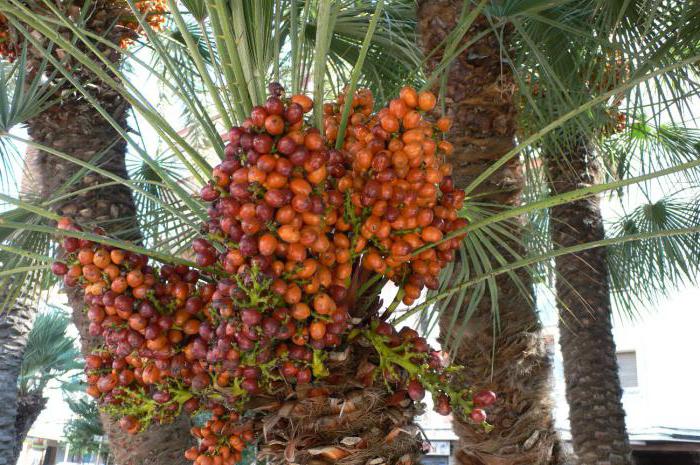

One of the resorts of Elche in Spain is famous for its park of date palms (since 2000 the park is included in the UNESCO World Heritage List), of which about 300 thousand are planted here, dates are harvested here regularly.
Pruning leaves
The date palm is gradually forming in a comfortable home environment. As it grows, the plant is transplanted and the excess foliage is trimmed.
Pruning which leaves involve proper care of the date: dead;
additional (on some varieties, extra shoots are specially cut off).
Dates often get sick, especially in winter, but you should not rush to cut off half-yellow leaves. A weakened palm draws sap from dying leaves, and they are an additional source of its nutrition.
When pruning dates at home, the trunk must not be damaged. If part of the root system of a palm tree is exposed during the growth process, half of the leaves are urgently cut to minimize moisture evaporation. Pruning correctly will allow you to grow a tall date tree without additional fertilization costs.
Read also How to prepare remontant strawberries for winter
Roystowna palm
Royal Palm (Roystonea) - has a chic look corresponding to the name, standing out from its surroundings and landscape. The height of the tree can reach 40 m, the trunk is smooth gray, at its top is a crown of huge feathery leaves up to 8 m long and 2 m wide.The plant is monoecious: male and female flowers are located on the same tree below the crown.
Roystouneya has 17 species, distributed in the southern states of the United States, in Central and South America, in the West Indies.The most popular species are the Cuban palm (Roystonea regia) and the royal vegetable palm, from which the edible, succulent apical buds, called "kale", are harvested.
Roystones are planted as a decorative decoration along boulevards and avenues in cities of the tropical region, along the edge of beaches, they are often used for decoration in landscape design.


Everything that grows on the Roystonee palm tree is successfully used by humans: trunks are used in construction, leaves and fibers are used to make roofing and wickerwork, livestock eats fruits with pleasure, and palm oil is produced from seeds.
In which countries do they grow?
Banana is one of the oldest plants cultivated by man. As the Russian scientist Nikolai Ivanovich Vavilov established in the course of his many years of research, his homeland is Southeast Asia and the Malay Archipelago. In this section, we'll take a look at where the banana grows and in which countries it is produced the most.
In which countries do bananas grow? Nowadays, they are grown in at least 107 countries in Asia, Latin America and Africa, which have a humid and tropical climate. It is used like:
- food product (fresh and dried);
- base for making banana beer and wine;
- raw materials for fiber production;
- ornamental plant.
Of course, the main purpose of banana fruit is for food. The leader in the consumption of these fruits per capita is the small African country of Burundi - here every citizen eats almost 190 kg per year. It is followed by Samoa (85 kg), Comoros (almost 79 kg) and Ecuador (73.8 kg). It is clear that in these countries this culture is one of the main food products. For comparison: every Russian on average annually consumes just over 7 kg of bananas.
The banana crop ranks 4th in the world among cultivated plants, after rice, wheat and corn. This is not least due to its high calorie content - 91 kcal per 100 g of product, which is higher than, for example, potatoes (83 kcal per 100 g). The only drawback is how much the banana grows. Indeed, before flowering begins, you need to wait 8 or more months until the plant itself matures.
The export of bananas, which became possible with the advent of refrigeration at the beginning of the 20th century, eventually turned into a highly profitable business and remains so in our time.
The list of leaders in the production of bananas for 2013 (in million tons) looks like this:
- India (24.9).
- China (10.9).
- Philippines (9.3).
- Ecuador (7).
- Brazil (6.9).
One should immediately answer the common question "Do bananas grow in Africa?" As noted, they are native to tropical and humid countries, so yes. However, there are not so many of them here as in Asian and Latin American countries - the leader in the African continent, Tanzania, and that produced 2.5 million tons in 2013.
Bismarckia noble
The genus Bismarckia (Bismarckia Nobilis) includes the only species, which is also called the Bismarck palm, named after the 1st chancellor of Germany. This drought-resistant tree is distinguished by its original appearance and color, and is widespread on the island of Madagascar.
The petioles grow from a single gray-yellow-brown trunk with annular depressions (45 to 80 cm in diameter at the base). In nature, palm trees grow up to 12-25 m tall. Beautiful silvery-blue, rounded leaves reach 3 m, dividing into segments at the ends. The petioles are 2-3 m long, protected by thorns and covered with white wax.
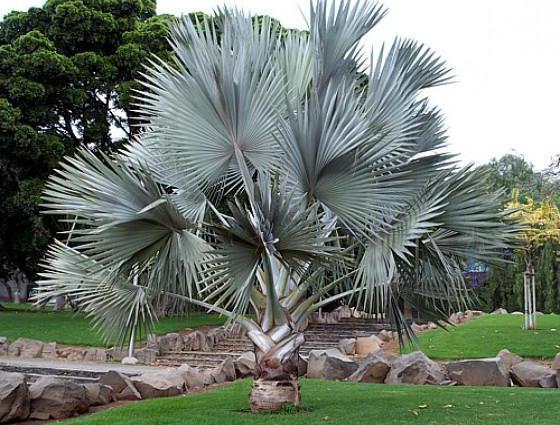

The plant is dioecious, flowers grow on dark purple stems, fruits are brown ovoid up to 48 cm in length, inside there is a drupe with one seed. Bismarckia leaves are used for the manufacture of roofing and wickerwork; sago with a bitter taste is prepared from the core.
Such a palm tree can be successfully grown at home, it looks spectacular in the interior and is unpretentious in care.
Washingtonia filamentous or filamentous
The Latin name is Washingtonia filifera. She is native to the southwest of North America. This is a very beautiful fan palm. The trunk in its homeland reaches a height of 30 m. The leaves are fan-shaped with openwork thin threads hanging between the segments of the leaf.


Compound inflorescences. The flowers are bisexual with a strong odor. The fruit is a non-opening drupe.
It blooms and bears fruit abundantly on the Black Sea coast, the fruits ripen in December. This is one of the fastest growing palms.
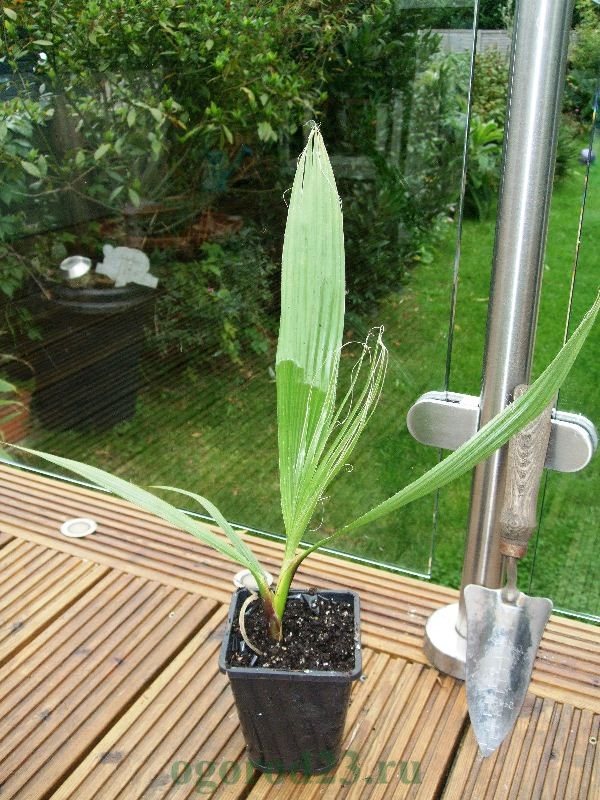

Easily propagated by seeds. Germination rate is 80-90%. At a temperature of 35 ° C in greenhouse conditions, seedlings appear on the seventh day. Under normal conditions - within a month.
This type of palm tree will look good in spacious rooms - halls, offices, greenhouses. Care is easy, but there is one feature - in winter it will feel more comfortable in cool conditions. If you cannot maintain the temperature in the room no higher than 20 ° C (preferably 15-18 ° C), then the dishes with the plant should be kept in a pan with water and sprayed daily. At high indoor temperatures and dry air, it can shed leaves.


Seeds remain viable for up to 5 years.
Decorative and indoor palms
For lovers of exotic plants, palms are great, since growing them at home does not present any difficulties in care. In the countries of the European region and Russia, ornamental palm trees take root best in winter gardens and greenhouses, where you can create a suitable microclimate for them, because the plant is still southern and thermophilic.
The plant propagates by seeds, which can be found in specialized flower shops. The most common species that can be grown in apartments and houses:
- Date palm, often grown from seed, at home it can grow up to 2 m, forming a lush crown over a shaggy trunk.
- Dracaena has been used for several 10 years in the gardening of houses and apartments, propagates by seeds and cuttings, the leaves are light or dark green, less often striped, can form several trunks.
- Areca - has a flexible trunk, decorated with feathery leaves of a meter in length.
- Trachikarpus is a decorative type of palm trees with an original bottle-shaped trunk and fan-shaped leaves, blooms with white and yellow flowers with a pleasant smell, the fruits are blue-black.
- Hovea Foster is a popular species, easy to care for, little susceptible to attack by pests and diseases, the leaves are dark green, etc.
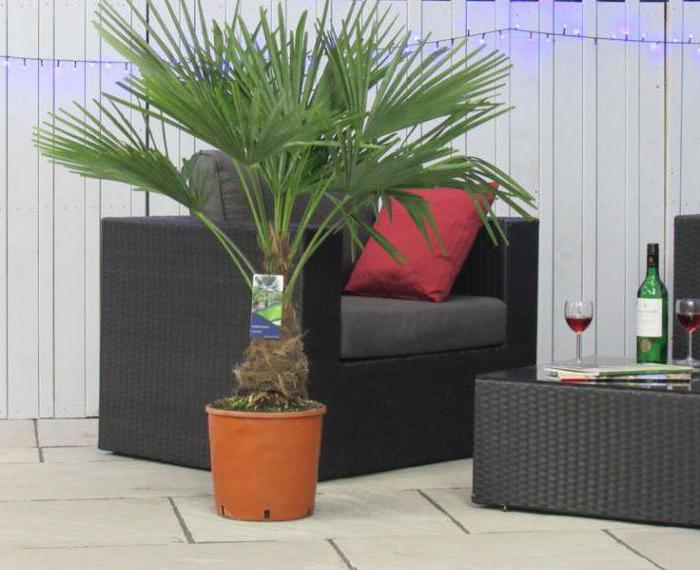

Diseases and pests


In general, palm plants are quite resistant to diseases and attacks of insect pests. However, illnesses can happen. Let's consider the main ones.
Among diseases most often found:
- Leaf spot... The disease is the result of improper watering, high humidity or hypothermia. Caused by a fungus. Control measures: reduction of watering, treatment of leaves with fungicides.
- Penicillosis of palms. It appears as spots on the upper leaves, which are then covered with a white bloom. Caused by a fungus. Fungicides and the removal of damaged leaves help.
- Root rot occurs due to stagnant water in the pot and contaminated soil. The disease progresses very quickly. The leaves darken and the roots die off. Root rot is difficult to treat.
There are also diseases that are caused not by the action of fungi, but by improper care. They most often appear as wilting of the tips of the leaves. In this case, you just need to create suitable conditions for the palm trees.
Of insect pests the greatest harm is caused by:
- Mealybug. The action of the parasite affects the growth and appearance of the plant.
- Shield... The insect harms the leaves, which take on ugly shapes.
To cope with parasites will help insecticides Vertimek, Fitoverm, etc. You can also use folk remedies. For example, garlic infusion or ammonia.
Caring for a palm tree in an apartment
The most important rule when growing a decorative palm tree at home is to create high humidity and proper lighting. With dry air in the apartment due to winter heating, the plants must be frequently sprayed and watered with distilled or filtered water: in the summer months - 2-3 times a week, in the winter - every day.
Every year, a young palm tree needs to be replanted, picking up a more spacious pot, more mature trees - less often. Plants and their roots are afraid of drafts, so it is not recommended to put the tubs on the windowsill or on the floor. Many types of palms cannot tolerate direct sunlight, preferring bright and diffused lighting.
However, at home, all plants only bloom, and the rare set fruits never ripen. Thus, it will not be possible to find out what is growing on the palm tree, but an exotic green beauty in a tub in the middle of the house will create a cozy tropical corner and a positive emotional atmosphere.
Description. General information
In botany, an ornamental houseplant, the rape palm, is called Rhapis excelsa. This genus belongs to the palm family, belongs to the subfamily Coryphoideae. Includes about ten varieties of fan-type palms. They have some similarities, however, individual samples of rapeseed, like plants, may differ in size. This multi-stemmed palm is popular in almost all countries of our planet. Most often you can hear this name - LadyPalms. An example of a rapis palm tree in the photo.


People who have learned about the existence of this palm tree are interested in what is the homeland of the plant. The answer to this question is: Asia. But the natural habitat of Rhapis excelsa is very extensive: rapese grows in the Southeast of this continent - from Sumatra to the southern provinces of China and the prefectures of Japan.
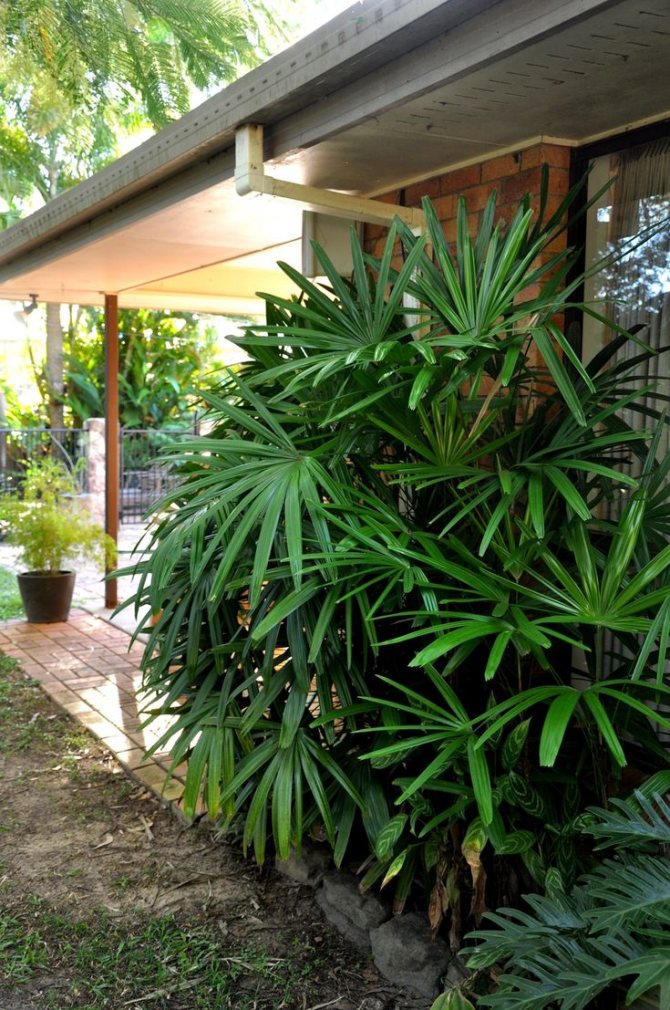

Some species are characterized by cold resistance. In regions where a moderately warm or subtropical climate prevails, fan palms are grown in the open air. Their tops are crowned with up to 10 pieces of feathery leaves with a glossy surface and a deep dark green tint.
Rhapis excelsa is a dioecious plant. But in females and males, there are no external differences. Fleshy flowers located on a rapeseed palm are 3-petal, white. They form small inflorescences at the top of the crown in a spiral. The fruits of the rapeseed palm are inedible.
